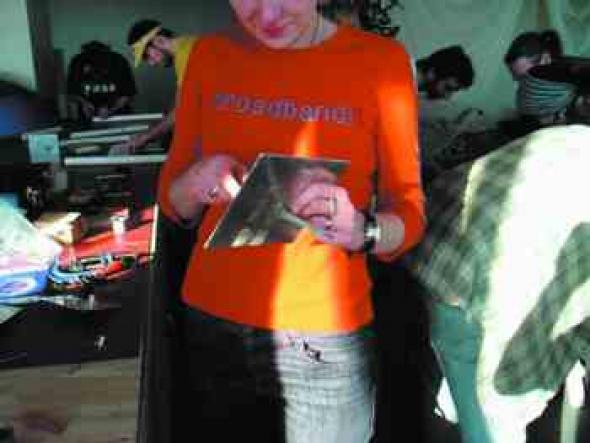Network the People
Have you noticed the strange sight of Parcelforce workers delivering bundles of copper wire, sheets of aluminum, plastic tubing and reels of cable to inauspicious looking buildings of late? Or have you noticed the empty Jolt cans and pizza boxes overflowing from bin bags all over the city? We can confirm that these seemingly unrelated phenomena are in fact connected: the wireless network community has been born! For several years now, enthusiasts – fuelled by pure idealism and junk food – have been building local area networks, operating over licensed 802.11 wireless technology, to provide communities with broadbandwidth connections for next to no money. Inspired to join in the fray, Mute has recently started building too. Here we present some of the results, as well as a few words from those that inspired us – on technical and other matters
YOUAREHEREYouAreHere was initiated by Metamute, Mute’s online presence. The project aims to resource local media practice in the East End of London through platforms for trade and debate. This area has a wide array of wireless network projects (such as free2air.org, ambienttv.net and consume.net) which YouAreHere aims to support by setting up workshops and contributing ideas to their development.
Although YouAreHere has many other components (a Twiki, email lists, screenings, talks, a trade show), one of its central objectives is to help build a wireless backbone from Limehouse to Hackney Central, and potentially beyond. The next step will be to use the wireless network to increase exchange between groups active in the local area. Users would be able to share files, keep each other informed about events, put out requests or stream live events.
Simon Worthington
Feel free to add any suggestions about this project on YouAreHere’s website[http://youarehere.metamute.com]
FREE NETWORKSFree Networks – an international collective of IT network builders and enthusiasts – is undergoing a remarkable period of innovation and collaboration. As with so many social movements, this locally oriented and globally integrated initiative, might appear to have come from nowhere but actually has well-established roots. From the pre-internet BBSs to the more recent development of Independent Media Centres (IMCs), there has been a long history of those struggling to gain autonomy from prescriptive commercial markets and technologies. The setting is perfectly irresistible: a compressed economic environment with global capitalism under withering scrutiny. The information age has boiled down the magic of telecommunications into a set of modular components that any of us can adopt and explore. Recent wireless Local Area Network initiatives illustrate just the barest outline of this crude transformation of the topology of power by its users.
At a recent summit in Seattle organised by Wireless Seattle – a not-for-profit community project – leading protagonists from community area networks across the US and UK gathered to confer about establishing support structures and co-ordinating local networking needs. Now Free Network initiates worldwide are creating prototypes in their communities, adapting and customising off-the-shelf components to their own ends. Throughout the UK, from the urban sprawl of major cities to the isolated pockets of rural hamlets, the light of new independence shines brightly through the actions of those with the insight to share what they have on terms that cut against the commercial grain and inspire. Trip the loop, make your switch, consume the net!
James Stevens [http://www.freenetworks.org/][http://www.consume.net/]
PUSH PACKETS TO CONSUMEAn often overlooked problem that needs to be solved in order to make the Consume wireless network project come together is that of routing. This is the art and science of getting packets from A to B – and there’s far more to it than plugging in and turning on.
Consider trying to drive across the UK without a road atlas. Try getting anywhere. Without that atlas, you’re lost. This is what a routing table is – an atlas of the network, from a packet-eye view. Now imagine if every motorway junction on the M25 could disappear at any time; a network is actually a living, breathing thing. Routing protocols enable routers to build the road map dynamically.
Now picture a road network with more one-way streets than dual carriageways. One of the challenges facing wireless networks is the prevalence of unidirectional links; you might be able to get a signal to your neighbour, but she might not be able to get one to you. Through sharing state, and Dijkstra’s Algorithm, routers push packets in the right direction.
Building a network which can cope with these variables, and yet heal itself rapidly when connections break, is the highest form of network ninjitsu. The challenge faced by Consumers is the same one that every telephone company faces. Routers are smart packet pushers.
Bruce M. Simpson
Simon Worthington <simon AT metamute.com> is co-editor and publisher of Mute
James Stevens <james AT spc.org> is a founder member of London’s media lab Backspace, is currently running its successor, Deckspace, and a major contributor to the Consume wireless networking project
Bruce M. Simpson <bms AT spc.org>
Mute Books Orders
For Mute Books distribution contact Anagram Books
contact@anagrambooks.com
For online purchases visit anagrambooks.com








